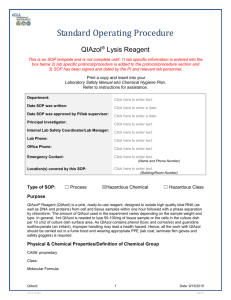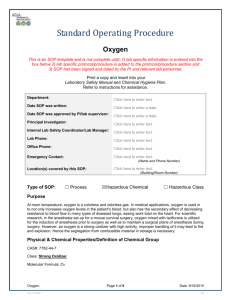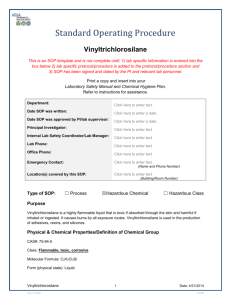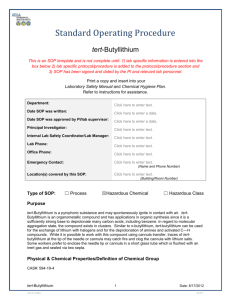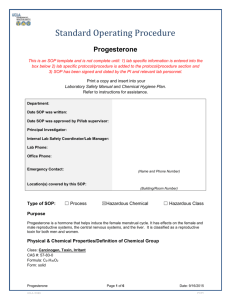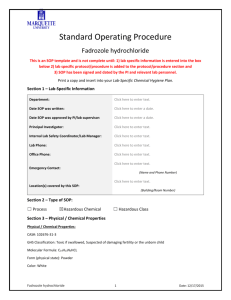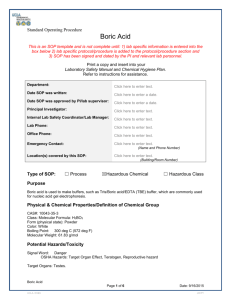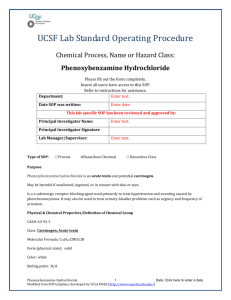Guanidine Hydochloride - UCLA David Geffen School of Medicine
advertisement
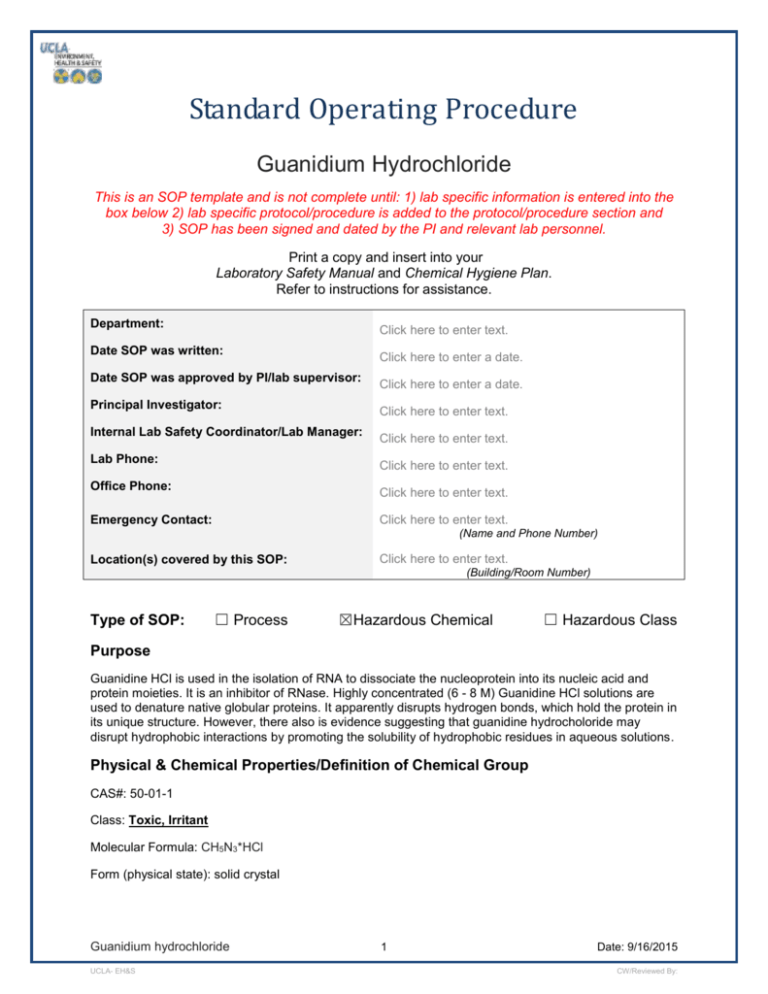
Standard Operating Procedure Guanidium Hydrochloride This is an SOP template and is not complete until: 1) lab specific information is entered into the box below 2) lab specific protocol/procedure is added to the protocol/procedure section and 3) SOP has been signed and dated by the PI and relevant lab personnel. Print a copy and insert into your Laboratory Safety Manual and Chemical Hygiene Plan. Refer to instructions for assistance. Department: Click here to enter text. Date SOP was written: Click here to enter a date. Date SOP was approved by PI/lab supervisor: Principal Investigator: Click here to enter text. Internal Lab Safety Coordinator/Lab Manager: Lab Phone: Click here to enter a date. Click here to enter text. Click here to enter text. Office Phone: Click here to enter text. Emergency Contact: Click here to enter text. (Name and Phone Number) Location(s) covered by this SOP: Click here to enter text. (Building/Room Number) Type of SOP: ☐ Process ☒Hazardous Chemical ☐ Hazardous Class Purpose Guanidine HCl is used in the isolation of RNA to dissociate the nucleoprotein into its nucleic acid and protein moieties. It is an inhibitor of RNase. Highly concentrated (6 - 8 M) Guanidine HCl solutions are used to denature native globular proteins. It apparently disrupts hydrogen bonds, which hold the protein in its unique structure. However, there also is evidence suggesting that guanidine hydrocholoride may disrupt hydrophobic interactions by promoting the solubility of hydrophobic residues in aqueous solutions. Physical & Chemical Properties/Definition of Chemical Group CAS#: 50-01-1 Class: Toxic, Irritant Molecular Formula: CH5N3*HCl Form (physical state): solid crystal Guanidium hydrochloride UCLA- EH&S 1 Date: 9/16/2015 CW/Reviewed By: Color: White Melting point: 178-185°C Potential Hazards/Toxicity Guanidium Hydrochloride is a toxic salt and irritant. It can cause acute toxicity by ingestion or inhalation, and is also a skin and eye irritant. GHS Classification Acute toxicity, Oral (Category 4) Acute toxicity, Inhalation (Category 5) Skin irritation (Category 2) Eye irritation (Category 2A) Oral LD50 LD50 Oral - rat - 475 mg/kg Remarks: Behavioral:Altered sleep time (including change in righting reflex). Behavioral:Excitement. Diarrhea LD50 Oral - mouse - 571 mg/kg Remarks: Behavioral:Altered sleep time (including change in righting reflex). Behavioral:Muscle contraction or spasticity. Behavioral:Irritability. LD50 Oral - rat - 1,120 mg/kg Inhalation LC50 LC50 Inhalation - rat - 4 h - 5.3 mg/l Personal Protective Equipment (PPE) Respirator Protection Respirators should be used only under any of the following circumstances: As a last line of defense (i.e., after engineering and administrative controls have been exhausted). When Permissible Exposure Limit (PEL) has exceeded or when there is a possibility that PEL will be exceeded. Regulations require the use of a respirator. An employer requires the use of a respirator. There is potential for harmful exposure due to an atmospheric contaminant (in the absence of PEL) As PPE in the event of a chemical spill clean-up process Lab personnel intending to use/wear a respirator mask must be trained and fit-tested by EH&S. This is a regulatory requirement. (https://www.ehs.ucla.edu/ep/ih/resp) Hand Protection Gloves must be worn. Use proper glove removal technique to avoid any skin contact. NOTE: Consult with your preferred glove manufacturer to ensure that the gloves you plan on using are compatible with Guanidium hydrochloride. Refer to glove selection chart from the links below: http://www.ansellpro.com/download/Ansell_8thEditionChemicalResistanceGuide.pdf OR Guanidium hydrochloride UCLA- EH&S 2 Date: 9/16/2015 CW/Reviewed By: http://www.allsafetyproducts.com/glove-selection-chart-chemical-breakthrough-ratings.html OR http://www.showabestglove.com/site/default.aspx OR http://www.mapaglove.com/ Eye Protection ANSI approved properly fitting safety glasses or chemical splash goggles. Face shield is also recommended. Skin and Body Protection Lab coats should be worn. These laboratory coats must be appropriately sized for the individual and be buttoned to their full length. Laboratory coat sleeves must be of a sufficient length to prevent skin exposure while wearing gloves. Full length pants and close-toed shoes must be worn at all times by all individuals that are occupying the laboratory area. The area of skin between the shoe and ankle should not be exposed. Hygiene Measures Wash thoroughly and immediately after handling. Remove any contaminated clothing and wash before reuse. Engineering Controls Make sure to handle product away from drains so it does not get released. Can prepare in fume hood to prevent inhalation of aerosols. First Aid Procedures If inhaled Move into the fresh air immediately and give oxygen. If not breathing give artificial respiration. Seek medical attention immediately. In case of skin contact Immediately flush skin with plenty of water for at least 15 minutes while removing contaminated clothing and shoes. Wash any contaminated clothing before reuse. Thoroughly clean shoes before reuse. Seek medical attention immediately. In case of eye contact Check for and remove any contact lenses. Rinse thoroughly with plenty of water for at least 15 minutes and consult a physician. Seek immediate medical attention and continue eye rinse during transport to hospital. If swallowed Do NOT induce vomiting unless directed by medical personnel. Never give anything by mouth to an unconscious person. Seek medical attention immediately. Special Handling and Storage Requirements Avoid contact with skin and eyes. Avoid formation of dust and aerosols. Provide appropriate exhaust ventilation at places where dust is formed. Keep container tightly closed in a dry and well-ventilated place. Hygroscopic Spill and Accident Procedure Guanidium hydrochloride UCLA- EH&S 3 Date: 9/16/2015 CW/Reviewed By: Chemical Spill Dial 911 and x59797 Spill – Assess the extent of danger. Help contaminated or injured persons. Evacuate the spill area. Avoid breathing vapors. If possible, confine the spill to a small area using a spill kit or absorbent material. Keep others from entering contaminated area (e.g., use caution tape, barriers, etc.). Small (<1 L) – If you have training, you may assist in the clean-up effort. Use appropriate personal protective equipment and clean-up material for chemical spilled. Double bag spill waste in clear plastic bags, label and take to the next chemical waste pick-up. Large (>1 L) – Dial 911 (or 310-825-1491 from cell phone) and EH&S at x59797 for assistance. Chemical Spill on Body or Clothes – Remove clothing and rinse body thoroughly in emergency shower for at least 15 minutes. Seek medical attention. Notify supervisor and EH&S at x59797 immediately. Chemical Splash Into Eyes – Immediately rinse eyeball and inner surface of eyelid with water from the emergency eyewash station for 15 minutes by forcibly holding the eye open. Seek medical attention. Notify supervisor and EH&S at x59797 immediately. Medical Emergency Dial 911 or x52111 Life Threatening Emergency, After Hours, Weekends And Holidays – Dial 911 (or 310-825-1491 from cell phone) or contact the Ronald Reagan UCLA Medical Center (emergency room) directly at x52111 (located at 757 Westwood Plaza, enter from Gayley Avenue). Note: All serious injuries must be reported to EH&S at x59797 within 8 hours. Non-Life Threatening Emergency – Go to the Occupational Health Facility (OHF), x56771, CHS room 67-120 (This is on the 6th floor, 7th corridor, room 120. Enter through the School of Dentistry on Tiverton Drive and proceed to the “O” elevator to the 6th floor.)Hours: M - F, 7:30 a.m. to 4:30 p.m. At all other times report to Ronald Reagan UCLA Medical Center (emergency room) at x52111. Note: All serious injuries must be reported to EH&S at x59797 within 8 hours. Needle stick/puncture exposure (as applicable to chemical handling procedure) – Wash the affected area with antiseptic soap and warm water for 15 minutes. For mucous membrane exposure, flush the affected area for 15 minutes using an eyewash station. Page the needle stick nurse by dialing 231 from a campus phone, enter 93333 when prompted and then enter your extension. Hours: M – F, 8:00 a.m. to 4:00 p.m. At all other times report to Ronald Reagan UCLA Medical Center (emergency room) at x52111. Note: All needle stick/puncture exposures must be reported to EH&S at x59797 within 8 hours. Decontamination/Waste Disposal Procedure Use proper personal protective equipment and properly dispose chemical. General hazardous waste disposal guidelines: Label Waste Affix an on-line hazardous waste tag on all waste containers using the WASTe Online Tag Program https://ehs.ucop.edu/waste as soon as the first drop of waste is added to the container Store Waste Store hazardous waste in closed containers, in secondary containment and in a designated location Double-bag dry waste using transparent bags https://www.ehs.ucla.edu/hazwaste/management/containers Waste must be under the control of the person generating & disposing of it Dispose of Waste Dispose of regularly generated chemical waste within 90 days Guanidium hydrochloride UCLA- EH&S 4 Date: 9/16/2015 CW/Reviewed By: Call EH&S at x61887 for questions Empty Containers o Dispose as hazardous waste if it once held extremely hazardous waste (irrespective of the container size) https://www.ehs.ucla.edu/hazwaste/types/extremely-hazardous o Consult waste pick-up schedule https://www.ehs.ucla.edu/hazwaste/management/pick-ups Prepare for transport to pick-up location Check on-line waste tag Write date of pick-up on the waste tag Use secondary containment Safety Data Sheet (SDS) Location Online SDS can be accessed at http://msds.ehs.ucla.edu. Protocol/Procedure Quantities covered by this SOP: 0 - 100 g from a 2 kg reagent bottle Conditions covered by this SOP: 18 °C - 25 °C (room temperature) 15ml of 6M Guanidine- HCl stock 1. Dissolve 8.6 g of guanidine hydrochloride into 7.5ml of dH2O. 2. Once dissolved, add water to 15 ml and pH to 7.5 Phenol/Chloroform RNA Isolation Method Guanidine HCl Homogenization Buffer (100 ml) for RNA Isolation contains: 1. 76.424 g Guanidine HCl (8.0M final concentration), 2. 820.3 mg Sodium Acetate, (0.1M final concentration pH 5.5), 3. 77.125 mg Dithiothreitol (5.0mM final concentration) 4. 0.5% Sodium Lauryl Sarcosinate Extraction with Phenol: It is typically easiest to carry the extraction out in 1.7–2 mL eppendorf tubes. 1. Biological samples are lysed and homogenized in the presence of a highly denaturing guanidine HCl-containing buffer, which immediately inactivates RNases to ensure isolation of intact RNA 2. Dilute your sample to 100–700 µL or divide your samples into tubes such that you have no more than 700 µL per tube. It is difficult to do the extraction with volumes smaller than 100 µL. The sample can be concentrated again after precipitation. 3. Add an equal volume of phenol to the tube, vortex vigorously to mix the phases. 4. Spin in a microfuge at top speed for 1–2 min to separate the phases. 5. Remove the aqueous phase to a new tube, being careful not to transfer any of the protein at the phase interface. 6. Repeat the phenol extraction two more times. 7. Extract the sample two times with an equal volume of chloroform:isoamyl alcohol to remove any trace phenol. 8. Continue to nucleic acid precipitation NOTE Any deviation from this SOP requires approval from PI. Guanidium hydrochloride UCLA- EH&S 5 Date: 9/16/2015 CW/Reviewed By: Documentation of Training (signature of all users is required) Prior to conducting any work with guanidine hydrochloride, designated personnel must provide training to his/her laboratory personnel specific to the hazards involved in working with this substance, work area decontamination, and emergency procedures. The Principal Investigator must provide his/her laboratory personnel with a copy of this SOP and a copy of the SDS provided by the manufacturer. The Principal Investigator must ensure that his/her laboratory personnel have attended appropriate laboratory safety training or refresher training within the last one year. Principal Investigator SOP Approval Print name __________________________Signature___________________________ Approval Date: I have read and understand the content of this SOP: Name Signature Date Click here to enter text. Click here to enter a date. Click here to enter text. Click here to enter a date. Click here to enter text. Click here to enter a date. Click here to enter a date. Click here to enter a date. Click here to enter text. Click here to enter text. Click here to enter text. Click here to enter a date. Click here to enter text. Click here to enter a date. Click here to enter text. Click here to enter a date. Click here to enter text. Click here to enter a date. Click here to enter text. Click here to enter a date. Click here to enter text. Click here to enter a date. Click here to enter text. Click here to enter a date. Guanidium hydrochloride UCLA- EH&S 6 Date: 9/16/2015 CW/Reviewed By: Click here to enter text. Click here to enter a date. Click here to enter text. Click here to enter a date. Click here to enter text. Click here to enter a date. Guanidium hydrochloride UCLA- EH&S 7 Date: 9/16/2015 CW/Reviewed By:
